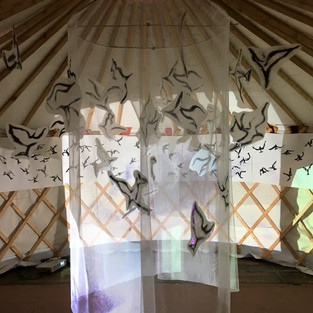“Humanity is our ultimate community, and everyone plays a crucial role.” Yehuda Berg
Take a look at the first picture. This is a community artwork that I made during the same residency that produced Flock, which I talked about in May. It is called Murmur and took the idea of how starlings flock together making haunting, ever shifting shapes in the sky. Starlings are known as the ‘bovver boys’ of the bird world, and yet when they come together, they create such delicate beauty. I recently learnt that each bird in the flock has seven other birds whom they ‘attend to’, ensuring that they are safe and keeping them together. Each of the seven also have another seven they look after, and so on. The most stunning displays of ‘murmurations’ are created when there is a predator close, and the starlings flock together in such a way as to confuse their enemy and to hide themselves in the whole.
Years ago, anthropologist Margaret Mead was asked by a student what she considered to be the first sign of civilization in a culture. The students expected Mead to talk about fishhooks or clay pots or grinding stones. But no. Mead said the first sign of civilization was a femur that had been broken and then healed. She explained that in the animal kingdom, if you break your leg, you die. You cannot run from danger, get to the river for a drink or hunt for food. You are meat for prowling beasts. No animal survives a broken leg long enough for the bone to heal. A broken femur that has healed is evidence that someone has taken time to stay with the one that fell, has bound up the wound, has carried the person to safety and has tended the person to recovery. Helping someone else through difficulty is where civilisation starts, she said.
Take a look at the second image. This is an installation artwork, made from 1,000 porcelain birds coated in gunpowder, called Murmuration by Cai Guo-Qiang, an artist who usually works with fireworks but instead here has created an explosion of bird energy. I am currently working on a community art project which I and another artist (she who found out about the rule of seven starlings) hope to roll out across our town. It is called Murmur and we are enabling people from all different groups and experiences to be involved in making a bird per person. We aim to include everyone and already we have groups signed up as various as people with dementia, a writer’s group, allotment holders, adults with learning needs, care home residents and those with mental health issues. Eventually and when covid restrictions allow, we are going to gather our many birds to display them as a murmuration in one place and to bring the people who have been involved either individually or as part of their own support and club group activities, together in celebration. In the meantime, their birds and the birds of successive groups will go on display in shop windows and other ‘nesting sites’ around our town, hopefully delighting people as they go about their business. But also, reminding and encouraging everyone in our community that we are a civilization, according to Margaret Mead’s terms: That we cannot exist or survive alone, that we need each other and that together we are stronger and safer.
I think it is vital in this time of so much isolation that we hold onto this understanding of who we are. Not a herd, as the term ‘herd immunity’ suggests, but a community – a place where we as individuals care for the greater good, the other and not just for ourselves.
A group of researchers posed the question 'What does love mean?' to a group of 4 to 8-year-olds. There were many very lovely, honest answers, but the most moving might have been this one: a four-year-old child whose next-door neighbour was an elderly gentleman who had recently lost his wife. Upon seeing the man cry, the little boy went into the old gentleman's yard, climbed onto his lap, and just sat there. When his Mother asked what he had said to the neighbour, the little boy said, 'Nothing, I just helped him cry.'
So just maybe a good definition of civilisation is community, and maybe community is when we help each other heal, both in terms of our physical and immediate needs, and in terms of our mental and inner needs. A place where we make sure that a femur is mended, and that someone who is mourning can cry.
Take time to look at the pictures and consider these questions:
- How can we ‘attend’ to the other?
- How can we help each other heal?
- Who is my community?
Meditative Action:
You will need a piece of paper
- Fold your paper in a diagonal. Cut off the excess paper to create a square
- If you want, draw or write responses to the questions and other thoughts onto the paper square
- Follow instructions below to create your own paper bird
- Place in your home somewhere visible to the outside world to remind yourself of your connection with others
This meditation is commissioned by Leeds Methodist Mission






Comments